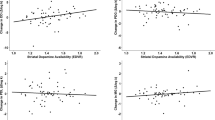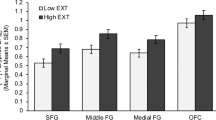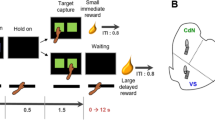Abstract
Psychopathy is a personality disorder that is strongly linked to criminal behavior. Using [18F]fallypride positron emission tomography and blood oxygen level–dependent functional magnetic resonance imaging, we found that impulsive-antisocial psychopathic traits selectively predicted nucleus accumbens dopamine release and reward anticipation-related neural activity in response to pharmacological and monetary reinforcers, respectively. These findings suggest that neurochemical and neurophysiological hyper-reactivity of the dopaminergic reward system may comprise a neural substrate for impulsive-antisocial behavior and substance abuse in psychopathy.
This is a preview of subscription content, access via your institution
Access options
Subscribe to this journal
Receive 12 print issues and online access
$209.00 per year
only $17.42 per issue
Buy this article
- Purchase on Springer Link
- Instant access to full article PDF
Prices may be subject to local taxes which are calculated during checkout


Similar content being viewed by others
References
Anderson, D.A. J. Law Econ. 42, 611–642 (1999).
Hare, R.D. Psychiatr. Clin. North Am. 29, 709–724 (2006).
Blair, R.J. Phil. Trans. R. Soc. Lond. B Biol. Sci. 363, 2557–2565 (2008).
Neumann, C.S. & Hare, R.D. J. Consult. Clin. Psychol. 76, 893–899 (2008).
Walters, G.D. Law Hum. Behav. 27, 541–558 (2003).
Skeem, J.L. & Mulvey, E.P. J. Consult. Clin. Psychol. 69, 358–374 (2001).
Edens, J.F., Poythress, N.G. Jr., Lilienfeld, S.O. & Patrick, C.J. Behav. Sci. Law 26, 529–541 (2008).
Smith, S.S. & Newman, J.P. J. Abnorm. Psychol. 99, 430–439 (1990).
Everitt, B.J. et al. Phil. Trans. R. Soc. Lond. B 363, 3125–3135 (2008).
Benning, S.D., Patrick, C.J., Hicks, B.M., Blonigen, D.M. & Krueger, R.F. Psychol. Assess. 15, 340–350 (2003).
Lewis, M.H., Gariepy, J.L., Gendreau, P., Nichols, D.E. & Mailman, R.B. Neuropsychopharmacology 10, 115–122 (1994).
Schott, B.H. et al. J. Neurosci. 28, 14311–14319 (2008).
Ferrari, P.F., van Erp, A.M., Tornatzky, W. & Miczek, K.A. Eur. J. Neurosci. 17, 371–378 (2003).
Couppis, M.H. & Kennedy, C.H. Psychopharmacology (Berl.) 197, 449–456 (2008).
Rodriguiz, R.M., Chu, R., Caron, M.G. & Wetsel, W.C. Behav. Brain Res. 148, 185–198 (2004).
Acknowledgements
We thank B. Knutson for kindly making the monetary incentive delay task available and C. Weiner and M. McHugo for assistance with fMRI scanning and data analysis. This research was funded by the National Institute on Drug Abuse (R01DA019670-04).
Author information
Authors and Affiliations
Contributions
J.W.B., R.M.K. and D.H.Z. designed the study. E.S.S. and A.N.S. recruited participants into the study and collected PET and personality data. J.W.B. collected fMRI data with assistance from E.S.S., and A.N.S., R.L., N.D.W. and R.M.K. performed single-subject PET data analysis and quality control. J.W.B. performed group level PET data analysis with assistance from M.T.T. J.W.B. analyzed fMRI data at all stages. M.S.A. and R.M.B. synthesized radio-labeled fallypride for PET scanning. S.D.B. provided conceptual advice, statistical support and supplementary analyses for the PPI data. R.L.C. oversaw all medical aspects of the protocol. C.E.S. and R.M.K. provided medical support for PET scanning. D.C. provided conceptual support and statistical advice for the study. J.W.B., M.T.T. and D.H.Z. wrote the manuscript with assistance from R.L.C.
Corresponding author
Ethics declarations
Competing interests
The authors declare no competing financial interests.
Supplementary information
Supplementary Text and Figures
Supplementary Figures 1–8, Supplementary Data, Supplementary Discussion and Supplementary Methods (PDF 879 kb)
Rights and permissions
About this article
Cite this article
Buckholtz, J., Treadway, M., Cowan, R. et al. Mesolimbic dopamine reward system hypersensitivity in individuals with psychopathic traits. Nat Neurosci 13, 419–421 (2010). https://doi.org/10.1038/nn.2510
Received:
Accepted:
Published:
Issue Date:
DOI: https://doi.org/10.1038/nn.2510
This article is cited by
-
Functional Connectivity of the Nucleus Accumbens across Variants of Callous-Unemotional Traits: A Resting-State fMRI Study in Children and Adolescents
Research on Child and Adolescent Psychopathology (2024)
-
Neural correlates of aggression in personality disorders from the perspective of DSM-5 maladaptive traits: a systematic review
Translational Psychiatry (2023)
-
A three-factor model of common early onset psychiatric disorders: temperament, adversity, and dopamine
Neuropsychopharmacology (2022)
-
Modeling Variation in Empathic Sensitivity Using Go/No-Go Social Reinforcement Learning
Affective Science (2022)
-
Effects of substance misuse on reward-processing in patients with attention-deficit/hyperactivity disorder
Neuropsychopharmacology (2021)



